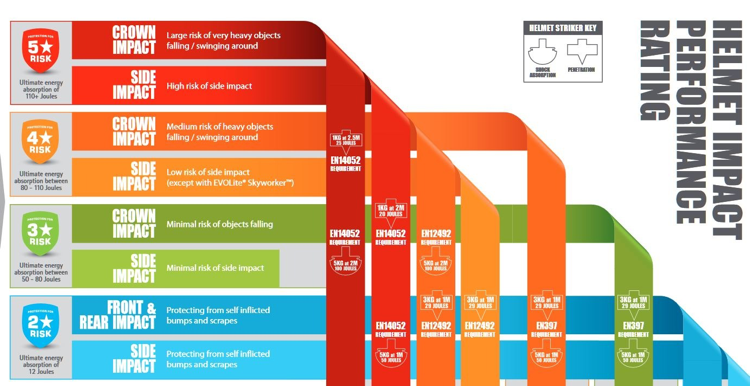$99 迪卡儂 Decathlon 多用途運動頭盔
陳奕迅Fans
41 回覆
45 Like
0 Dislike
Thz
cheap thing good

頭盔最好睇返安全標準
可以跟返迪卡儂攀岩頭盔個spec 望望
可以跟返迪卡儂攀岩頭盔個spec 望望
因為香城online係要保護埋條頸受既衝擊力
硬擊頭部,條頸會受埋衝擊力
硬擊頭部,條頸會受埋衝擊力
學到野

買左個基本款先,儲多少少pt錢買個靚d既


買左個基本款先,儲多少少pt錢買個靚d既

正! 踩單車丶野餐啱晒!
佢d spec好難明
攀岩、單車、滑雪、滑板頭盔有咩分別?
攀岩、單車、滑雪、滑板頭盔有咩分別?
頭盔有唔同安全標準
[img] [/img]
[/img]
攀岩嗰隻係EN 12492
我而家有嗰隻普通黃色地盤安全帽係EN397
[img]
 [/img]
[/img]攀岩嗰隻係EN 12492
我而家有嗰隻普通黃色地盤安全帽係EN397
多謝CHING
睇佢個網係有spec,而無寫點比較嗰D EN標準
就咁google search 個標準,通常都係content farm文,睇完都唔知
單車頭盔硬D定滑雪頭盔好
你幅圖好清楚,正
睇佢個網係有spec,而無寫點比較嗰D EN標準
就咁google search 個標準,通常都係content farm文,睇完都唔知
單車頭盔硬D定滑雪頭盔好
你幅圖好清楚,正
//Helmet Standards
There are different certifications for each sport and activity. For rock climbing, the official standard is EN 12492 and/or UIAA 106. If the helmet is sold for rock climbing in Europe, it must have the EN rating. The UIAA rating is optional, but widely accepted as a sought-after standard. The details of the UIAA requirement are public and you can read them here (and the EN cert was written using the UIAA requirements).
EN 12492 – Rock Climbing / Mountaineering (via UIAA or Satra testing facilities)
“The force transmitted to the head form as a result of the impact of the falling mass shall not exceed 8 kN for the vertical impact test, for the side impact test, for the front impact test and the rear impact test.”
The UIAA pictorial overview of the tests makes it a little clearer.
EN 1077 – Ski and Snowboard Helmets (via xsportsprotective)
“Tests ski/snowboard helmets for shock absorption, penetration and retention systems. Peak acceleration imparted to the head form cannot exceed 250 Gs. Tests also include a number of design requirements, such as area of coverage, field of vision, and clearance between the head and the shell.
Class A protects a larger area of the head and offers a higher degree of protection from penetration, while Class B offers more ventilation and better hearing but slightly less protection.”
If you want to geek out further on Class A and B, we found this super nerdy forum post that has pictures, diagrams, and a more detailed explanation.
Conclusion
Using a climbing helmet while skiing is still better than no helmet for protecting your cranium but it won’t protect you as well for collisions, the most common type of skiing accident. If you are convinced that you want to use a single helmet for climbing and skiing we highly recommend you use one certified for both skiing (EN 1077) and climbing (EN 12492 / UIAA 106)//
https://blog.weighmyrack.com/helmets-certified-for-climbing-and-skiing/
睇完都唔太明
就咁睇EN 1077好似好過 EN12492,前者可以防撞,不過應該兩個都OK掛
There are different certifications for each sport and activity. For rock climbing, the official standard is EN 12492 and/or UIAA 106. If the helmet is sold for rock climbing in Europe, it must have the EN rating. The UIAA rating is optional, but widely accepted as a sought-after standard. The details of the UIAA requirement are public and you can read them here (and the EN cert was written using the UIAA requirements).
EN 12492 – Rock Climbing / Mountaineering (via UIAA or Satra testing facilities)
“The force transmitted to the head form as a result of the impact of the falling mass shall not exceed 8 kN for the vertical impact test, for the side impact test, for the front impact test and the rear impact test.”
The UIAA pictorial overview of the tests makes it a little clearer.
EN 1077 – Ski and Snowboard Helmets (via xsportsprotective)
“Tests ski/snowboard helmets for shock absorption, penetration and retention systems. Peak acceleration imparted to the head form cannot exceed 250 Gs. Tests also include a number of design requirements, such as area of coverage, field of vision, and clearance between the head and the shell.
Class A protects a larger area of the head and offers a higher degree of protection from penetration, while Class B offers more ventilation and better hearing but slightly less protection.”
If you want to geek out further on Class A and B, we found this super nerdy forum post that has pictures, diagrams, and a more detailed explanation.
Conclusion
Using a climbing helmet while skiing is still better than no helmet for protecting your cranium but it won’t protect you as well for collisions, the most common type of skiing accident. If you are convinced that you want to use a single helmet for climbing and skiing we highly recommend you use one certified for both skiing (EN 1077) and climbing (EN 12492 / UIAA 106)//
https://blog.weighmyrack.com/helmets-certified-for-climbing-and-skiing/
睇完都唔太明
就咁睇EN 1077好似好過 EN12492,前者可以防撞,不過應該兩個都OK掛
我諗極限運動既頭盔都ok
我都係嘗試搵下對應一出城門撞到哥布林棍擊時應該戴邊隻盔好
甚至乎可唔可以承受水箭龜320磅既力一兩秒
幅圖我有拎過去香城online 裝備post嗰邊
睇下有冇讀過safety既安全主任解答下啦
幅圖我都係誤打誤撞先搵到
我都係嘗試搵下對應一出城門撞到哥布林棍擊時應該戴邊隻盔好
甚至乎可唔可以承受水箭龜320磅既力一兩秒
幅圖我有拎過去香城online 裝備post嗰邊
睇下有冇讀過safety既安全主任解答下啦
幅圖我都係誤打誤撞先搵到

無晒碼
想要冰袖 好熱
做運動要小心

